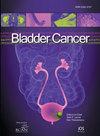低分割放疗治疗局限性膀胱癌
IF 1
4区 医学
Q4 ONCOLOGY
引用次数: 0
摘要
背景:膀胱癌的治疗采用多种放射治疗方案。目的:我们旨在评估低分割放射治疗(hyport)的早期毒性和预后,55Gy分20个部分。材料和方法:我们确定了40例接受明确低放射治疗的局限性膀胱癌患者。大多数患者为男性(62.5%),老年人(中位年龄82岁),Charlson合并症指数评分高(中位7,范围4-9),非手术候选人(80%)。68%的患者接受了经尿道膀胱肿瘤全切除术(turt), 33名患者(82.5%)接受了同期化疗。急性(& lt;=3mo)和晚期(>3mo)毒性根据CTCAE v4.0进行评估。使用Kaplan-Meier法估计生存结果。hyport术后中位随访时间为32个月(95% CI: 28-49个月)。结果:急性2级泌尿生殖系统(GU)和胃肠道(GI)毒性的总发生率各为40%,最常见的是尿频和腹泻。发生急性3级GU/GI毒性2例。3例患者(7.5%)出现2+级晚期毒性:2例2级GU和1例3级GI。77%的患者达到完全缓解(CR)。6例患者(20%)在中位时间9.1个月后出现疾病复发。估计2年DFS和2年DSS率分别为59% (95% CI, 45-78%)和78% (95% CI, 65-93%)。接受同步化疗(p = 0.003)和达到CR (p = 0.018)与改善的DSS呈正相关。该成分与较差的DSS相关(p = 0.015)。结论:在这个主要是老年人和体弱患者的队列中,低放射疗法具有良好的毒性和令人鼓舞的癌症控制结果。本文章由计算机程序翻译,如有差异,请以英文原文为准。
Hypofractionated Radiation Therapy (Hypo-RT) for the Treatment of Localized Bladder Cancer
BACKGROUND: Various radiotherapeutic regimens are used in the treatment of bladder cancer. OBJECTIVE: We aimed to evaluate early toxicity and outcomes associated with hypofractionated radiation therapy (Hypo-RT), 55Gy in 20 fractions. MATERIAL AND METHODS: We identified 40 patients who received definitive Hypo-RT for localized bladder cancer. Most patients were men (62.5%), elderly (median age 82), had high Charlson Comorbidity Index score (median 7, range 4–9) and were nonsurgical candidates (80%). Sixty-eight percent had a macroscopically complete transurethral resection of bladder tumor (TURBT) and 33 patients (82.5%) received concurrent chemotherapy. Acute (< =3mo) and late (>3mo) toxicities were assessed according to CTCAE v4.0. Survival outcomes were estimated using the Kaplan-Meier method. Median follow up after Hypo-RT was 32 months (95% CI: 28–49 months). RESULTS: Overall rates of acute grade 2 genitourinary (GU) and gastrointestinal (GI) toxicities were 40% each, most commonly urinary frequency and diarrhea. Two cases of acute grade 3 GU/GI toxicity occurred. Late grade 2+ toxicity occurred in 3 patients (7.5%): 2 grade 2 GU and 1 grade 3 GI. Seventy-seven percent achieved a complete response (CR). Six patients (20%) developed disease recurrence at a median time of 9.1 months. The estimated 2-year DFS and 2-year DSS rate were 59% (95% CI, 45–78%) and 78% (95% CI, 65–93%), respectively. Receipt of concurrent chemotherapy (p = 0.003) and achieving a CR (p = 0.018) were univariably associated with improved DSS. Tis component was associated with worse DSS (p = 0.015). CONCLUSION: Hypo-RT had a favorable toxicity profile and encouraging cancer control outcomes in this mostly elderly and frail patient cohort.
求助全文
通过发布文献求助,成功后即可免费获取论文全文。
去求助
来源期刊

Bladder Cancer
Medicine-Urology
CiteScore
1.60
自引率
0.00%
发文量
35
期刊介绍:
Bladder Cancer is an international multidisciplinary journal to facilitate progress in understanding the epidemiology/etiology, genetics, molecular correlates, pathogenesis, pharmacology, ethics, patient advocacy and survivorship, diagnosis and treatment of tumors of the bladder and upper urinary tract. The journal publishes research reports, reviews, short communications, and letters-to-the-editor. The journal is dedicated to providing an open forum for original research in basic science, translational research and clinical medicine that expedites our fundamental understanding and improves treatment of tumors of the bladder and upper urinary tract.
 求助内容:
求助内容: 应助结果提醒方式:
应助结果提醒方式:


